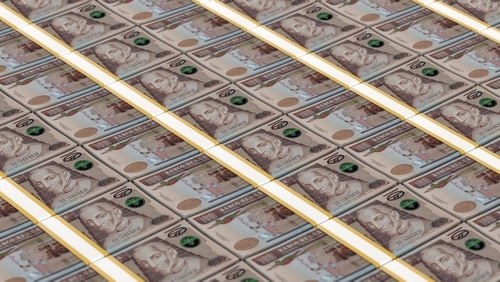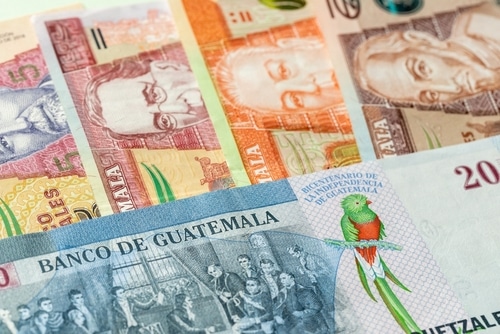If you’re planning a trip to Guatemala, sending money home, or conducting business in the country, it’s essential to understand the Guatemalan Quetzal (GTQ). Knowing how it works can help you avoid unnecessary exchange fees, recognize fair rates, and make confident financial decisions.
The Quetzal is Guatemala’s currency, but it also represents the country’s national identity and economic stability. Whether you’re wandering Antigua’s cobblestone streets or wiring funds to family in Guatemala City, a clear understanding of the Quetzal will make your experience smoother and more cost-effective.
In this Remitly guide, you’ll learn what the Guatemalan Quetzal is and how it originated, the current exchange rates and the factors influencing them, and the safest and most efficient ways to exchange money. We’ll also cover how to send money to Guatemala securely, practical tips for handling Quetzales day to day, and what to expect from Guatemala’s cost of living.
What is the Guatemalan Quetzal?
The Guatemalan Quetzal (GTQ) has been the country’s official currency since 1925. It’s named after the quetzal bird, a sacred symbol in Mayan culture that represents freedom and prosperity. In ancient times, quetzal feathers were used as currency and worn by royalty, giving the modern Quetzal deep historical roots and symbolism.
Cultural importance
The quetzal bird, featured on every banknote, is more than a national emblem: it also symbolizes liberty. According to legend, quetzals die if held in captivity, which has been interpreted as a metaphor for Guatemala’s road to independence and freedom.
Denominations
Guatemala uses both coins and banknotes:
- Coins: 1, 5, 10, 25, and 50 centavos, plus 1 Quetzal
- Banknotes: 1, 5, 10, 20, 50, 100, and 200 Quetzales
Each banknote features prominent Guatemalan figures such as José María Orellana, the president who introduced the Quetzal, along with cultural designs that showcase the country’s Mayan heritage. The 200 Quetzal banknote, the largest denomination, highlights Guatemala’s cultural diversity and commitment to national unity.
Security features
Modern banknotes include advanced anti-counterfeiting measures to ensure reliability, including watermarks and holographic security threads, color-shifting ink, microtext, and raised printing, as well as transparent windows (on higher denominations).
Always verify these features before accepting bills, especially from unofficial vendors or taxi drivers.
Current Guatemalan Quetzal exchange rates
As of late 2025, $1 USD equals approximately 7.8 to 8.0 GTQ, though this tends to fluctuate. The Quetzal is considered one of the more stable Central American currencies due to Guatemala’s conservative fiscal policies and steady flow of foreign remittances.
Factors that influence the exchange rate
- US dollar strength: Guatemala’s economy is closely tied to the United States, so any change in the dollar’s performance directly affects GTQ rates.
- Trade balance: Guatemala exports commodities such as coffee, sugar, and textiles. Fluctuations in global commodity prices can impact the currency’s strength.
- Inflation and interest rates: Low inflation and moderate interest rates help maintain consistent purchasing power.
- Remittance inflows: Money sent home from Guatemalans living abroad makes up over 18% of the nation’s GDP, supporting currency stability.
- Tourism and foreign investment: Visitor spending and international business create a steady demand for the Quetzal.
Understanding how the rates are set can help you make informed decisions when exchanging or sending money.

Historical overview
Over the past two decades, the Quetzal has generally stayed within a tight range of 7.5 to 8.2 per US dollar. This predictability is reassuring for travelers, investors, and families sending money home. Unlike other Latin American currencies, the GTQ has proven resilient against rapid devaluation.
That being said, it’s always a good idea to check real-time rates before exchanging or transferring funds. Reliable sources include the Bank of Guatemala, which provides up-to-date figures.
Where to exchange money for Guatemalan Quetzales
When visiting Guatemala or preparing to send money there, you’ll find several options for obtaining Quetzales. Each comes with different levels of convenience, cost, and safety.
-
Banks
Pros: Secure and trustworthy. Banks usually provide competitive exchange rates.
Cons: Limited operating hours, possible documentation requirements, and slower service.
Major banks such as Banco Industrial, Banrural, and BAC Credomatic have branches in most cities and tourist areas. Bring your passport and expect to fill out a brief form when exchanging larger amounts.
-
Exchange bureaus
Pros: Quick service and competitive rates.
Cons: Some charge commission, and not all are regulated.
You’ll find exchange bureaus at airports, malls, and in city centers. Always compare rates, ask about fees, and make sure you receive an official receipt. Reputable bureaus will display rates publicly and handle transactions transparently.
-
ATMs
Pros: Convenient, accessible 24/7, and typically near market rates.
Cons: Some machines charge withdrawal or foreign transaction fees.
ATMs are widespread in Guatemala City, Antigua, and other major cities. Use ATMs located inside banks or shopping centers to minimize the risk of potential theft. Withdraw cash during the day and avoid isolated machines.
-
Online currency services
Pros: Transparent pricing, convenience, and delivery to local accounts or cash pickup points.
Cons: Internet connection required; identity verification may be necessary.
Digital platforms allow users to exchange money or send cash to another country at real-time rates.
-
Unofficial exchanges
Unofficial money changers might offer appealing rates but carry high risk. Counterfeit notes are common, and unlicensed operations may violate local laws. For your safety, use official banks or trusted transfer platforms.
Sending money to Guatemala: what you need to know
Remittances are a lifeline for millions of Guatemalan households. Whether you’re supporting your family, paying for services, or funding a business, sending money safely and efficiently to someone in another country can make a real difference.
Popular transfer methods
- Bank transfers: Reliable but slower and often costly. Ideal for larger transactions where timing is less critical.
- Money transfer services: Designed for remittances, offering lower fees and faster processing.
- Cash pickup locations: Perfect for recipients without a bank account. Common in rural areas.
- Digital wallets: Growing in popularity, especially in cities with better internet coverage.
Comparing speed and cost
- Traditional banks: Delivery in 2 to 5 business days and may come with higher fees.
- Digital transfer services: Funds can arrive in minutes, often at a lower cost.
- Cash pickups: Usually available the same day through established networks.
When evaluating services, consider exchange rate margins, not just transfer fees. A small difference in rates can significantly affect how much money your recipient receives.
Choose providers licensed under financial regulations in both the sending and receiving countries.
Documentation for recipients
To receive funds in Guatemala, recipients generally need to provide the following:
- A valid government-issued ID
- A reference number or transaction code
- Name matching the sender’s information exactly
Failure to meet these requirements can delay or block payouts.
Practical tips for handling Guatemalan Quetzales
Budgeting and daily expenses
Guatemala is primarily a cash-based society, so planning your spending and carrying small bills for everyday transactions is a must. While large hotels, restaurants, and retail stores in major cities often accept credit cards, smaller shops, markets, and local eateries typically prefer cash.
Keeping a mix of denominations is helpful, as many small businesses are unable to make change for 100 or 200 Quetzal notes. For example, a cup of coffee in Antigua might cost around 15 GTQ (about $2 USD), a meal at a mid-range restaurant roughly 70 GTQ ($9 USD), and a short taxi ride about 25 GTQ ($3 USD).
What about tipping?
When it comes to tipping, customs are generally modest but appreciated. In restaurants, a 10% tip is customary if it’s not already included in the bill. Hotel staff typically receive 5 to 10 GTQ per bag or per night of housekeeping, and rounding up taxi fares is a polite gesture.
Following these local tipping norms helps travelers navigate daily expenses smoothly while showing appreciation for quality service.
Using credit and debit cards
Visa and Mastercard are widely accepted in Guatemala City and other major tourist destinations, though smaller towns and local markets often remain cash-only. If you plan to rely on cards, choose a travel-friendly option with low fees and strong security features when traveling.
Safety and counterfeit awareness
When carrying cash, divide it between different wallets or pockets and use hotel safes whenever possible. Guatemala is generally safe for travelers, but like anywhere, it’s smart to limit how much cash you carry at one time. Avoid exchanging money through street vendors or unofficial exchangers, since counterfeit notes can occasionally circulate.
Staying aware and organized will help you manage your money confidently and securely during your trip.
Cost of living in Guatemala: how far your money goes
By budgeting carefully, carrying small cash for daily expenses, following local tipping customs, and staying up-to-date with official tourism channels, you’ll find that everyday spending in Guatemala is both manageable and affordable. Understanding the country’s cost of living can also help you plan your trip without surprises.
| Category | Average Cost (USD) | Average Cost (GTQ) |
| Meal at a local restaurant | $5 | 40 GTQ |
| Local bus ride | $0.25 | 2 GTQ |
| Taxi (short distance) | $3 | 25 GTQ |
| Apartment rent (1BR, city center) | $450 | 3,500 GTQ |
| Utilities (monthly) | $100 | 780 GTQ |
| Coffee | $2 | 16 GTQ |
| Hotel (mid-range, per night) | $50 | 390 GTQ |
Urban vs. rural pricing differences
In urban areas like Guatemala City or Antigua, higher demand for housing and imported goods can drive up everyday costs, especially in tourist-heavy neighborhoods. By contrast, smaller towns and rural communities often offer lower prices for food, rent, and transportation, sometimes 30 to 40% cheaper.
However, rural areas may have fewer amenities, limited access to ATMs, and less reliable public transportation, so it’s wise to plan ahead and carry sufficient cash when traveling outside major cities.
Budgeting for your travels
Guatemala offers options for nearly every budget. Short-term visitors can expect to spend around 320–480 GTQ ($40–60 USD) per day on food, lodging, and local transport. Long-term residents typically live comfortably on 9,600–14,400 GTQ ($1,200–1,800 USD) per month, while budget travelers can manage on about 200 GTQ ($25 USD) a day.
Common prices include 25 GTQ ($3 USD) for breakfast, 15 GTQ ($2 USD) for coffee, and 2 GTQ ($0.25 USD) for a local bus ride. A mid-range hotel night costs about 390 GTQ ($50 USD), and rent for a one-bedroom apartment ranges from 2,000 to 3,500 GTQ ($260–450 USD) depending on the city.
Knowing these typical costs helps travelers and newcomers plan wisely, stretch their money, and enjoy Guatemala without overspending.
Make your Guatemala money transfers simple and secure
Understanding the Guatemalan Quetzal helps you manage money confidently, whether you’re exchanging cash, paying for daily expenses, or sending funds to family. Use trusted, regulated services to ensure transparent pricing and safe delivery. Before transferring money, take a moment to compare exchange rates and fees, since small differences can make a big impact.
For a reliable way to send money to Guatemala, Remitly offers secure transfers, clear rates, and multiple delivery options, helping you support loved ones back home quickly and confidently.
FAQs
Is the Guatemalan Quetzal a stable currency?
Yes. The Quetzal has been remarkably stable for years, trading within a narrow range against the US dollar. This consistency is supported by careful monetary management and steady remittance inflows.
Can I use US dollars in Guatemala?
You can use US dollars in tourist centers, hotels, and some larger stores. However, most everyday transactions require Quetzales. Street vendors, buses, and small businesses typically do not accept foreign currency. Plan to exchange or withdraw Quetzales upon arrival.
What’s the best way to send money to Guatemala?
Compare transfer methods to balance speed, cost, and convenience. Online platforms like Remitly are popular because they combine security with competitive rates.
How much cash should I bring to Guatemala?
Bring $100 to $150 USD in small bills for immediate expenses like transportation and meals. After arrival, rely on ATMs for local withdrawals. Major cities have reliable machines, but rural areas may not.
Are there limits on bringing Guatemalan Quetzales in or out of the country?
Yes. Any amount over $10,000 USD (or its equivalent in Quetzales) must be declared upon entering or leaving Guatemala. Failing to declare can result in fines or confiscation.

